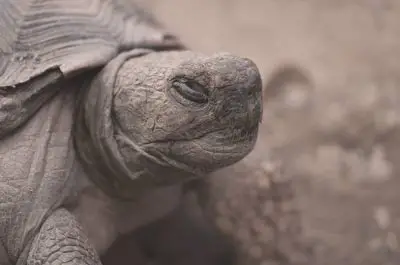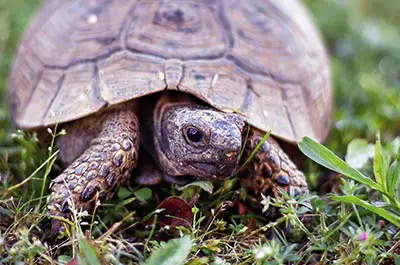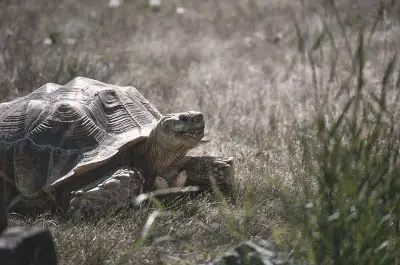Tortoises make great pets for those looking for an animal that is low maintenance and doesn’t require a lot of attention. However, if you’re new to tortoise ownership or want to be sure you’re doing everything you can to care for your pet tortoise, check out these ten tips!
Tortoises need a lot of sunlight.
Tortoises need calcium for healthy bones and shells.
They also require vitamin D3 for healthy bone development and proper metabolism (especially if they don’t get enough sunlight).

You can supplement their diet by adding reptile vitamins like Herptivite.
Tortoises need a lot of light, and one of the best kinds of light for them is the kind that emits UVB rays.
You can use a regular incandescent bulb or fluorescent tube to provide heat. Still, it’s crucial that you also provide a source of UVB light, whether it be natural or artificial.
This is the primary way they get their vitamin D3. They also need a basking area that gets a lot of sunlight to heat up and then lounge around in the sun. An otherwise healthy tortoise can develop metabolic bone disease without adequate access to sunlight.
Fiber is necessary for tortoises.
Tortoises are essentially designed to eat grass. It’s their natural food, and it provides them with fiber. Without proper fiber in the diet, they can develop digestive problems that could be deadly. You should provide your tortoise with daily access to dry grass or alfalfa hay.
Tortoises must have an adequate supply of fresh produce to stay healthy. This includes dark leafy greens like kale, bok choy, collard greens, mustard greens, dandelion leaves, parsley (any kind), endive, escarole, and turnip greens (cooked). They also need access to things like carrots (size and quantity depend on the animal), broccoli, Brussels sprouts (cooked), and other veggies.
Tortoises can eat fruit, but it should make up no more than 10% to 15% of their diet when they do. The best fruits are strawberries (fresh or dried), blueberries, pears (cut in half with seeds removed), papayas, and mangoes.
Tortoises need fiber in their diet, and they get fiber by eating grasses. If your tortoise cannot graze on grasses outside, you should provide a dish of greens and hay inside for him to snack on.
You’ll need an area for your tortoise to burrow into.
Your pet tortoise will need a place where he can feel secure and hide out when he wants some peace and quiet. This is especially important if you have a young tortoise that hasn’t developed its adult shell yet because they’re so vulnerable to predators.
Your tortoise’s habitat should be large enough to accommodate him comfortably. It should be at least 10 gallons for the first tortoise and 20 gallons for each additional tortoise kept together in one habitat. When you’re shopping for a habitat, make sure it has a sufficiently deep substrate bed that your pet can burrow into.
Tortoises are not especially active animals, but they move around now and then. During this time, any objects they might bump into could fall on them or trap them against something else. Make sure there are no sharp edges that are big enough to cause injury on any rocky structures you place in the habitat or rocks above it that could drop down on top of them if they were to climb under them.
Don’t use cedar mulch in the habitat, particularly for young tortoises. It can be toxic if they eat it, causing death or illness. You’ll need to clean out your pet’s habitat at least once per week by taking the substrate out and putting fresh substrate in its place.
The substrate should be about two inches deep, so your tortoise can burrow down into it if he wants to. Some tortoises prefer deeper bedding, while others like less of it for some reason that nobody understands yet! It varies from animal to animal, just like with us humans.
Tortoises need proper hydration.

Tortoises, like most reptiles, need to stay hydrated. Typically they get this water by drinking out of their bowl or by licking water off of the leaves in their habitat, but they need access to a source of free-standing water as well.
Your pet’s tank needs a water dish with fresh water in it at all times with large enough sides that he won’t easily knock it over. You should change his water at least once per day to keep the tank clean and free of bacteria.
If you live in an area with natural rainfall, your tortoise can enjoy that. If not, then you’ll need to provide him with a daily source of freshwater. This is particularly important during hot weather when they may need more access to water than usual.
This is especially important during hibernation and when temperatures drop below freezing. If left without access to adequate hydration for these prolonged periods, your tortoise could be at risk for developing something called “upper respiratory tract disease.”
When you place your tortoise’s habitat outside, make sure there’s shade available so he can get out of the sun if he wants to. You also need to make sure the temperature gets above 50 degrees F regularly during the day so he can warm up after spending time in his burrow or under his rocks sleeping.
You need a large enough enclosure for your tortoise.
Be sure to build your tortoise the right size enclosure with plenty of ventilation. Also, be sure to consider the space you have available in your yard for this purpose.
The enclosure needs to be at least 12 square feet per tortoise, with larger being better, of course. If they’re overcrowded or not provided with adequate space, they could develop stress-related illnesses that could prove fatal if not treated promptly.
They also need enough shade and shelter from the elements when they are outdoor pets. A large tortoise house is an excellent option if you can afford it or build your own. You’ll want one that will keep them out of the sun in the summer but allow them access to warmth when temperatures drop in wintertime.
Whether you plan on keeping your pet tortoise indoors or outdoors, make sure there’s plenty of ventilation. The habitat will get moist and humid when your pet uses it, which can lead to respiratory problems like “upper respiratory tract disease” if you aren’t careful.
Tortoises are easily injured by a fall from a height.
The most dangerous thing about owning a tortoise is that they’re easily injured when you mishandle them. If you drop them, even from a very low height, there’s a chance you could cause severe damage to their spine or shell.
Don’t hold your pet upside down by his shell! Instead, gently pick him up underneath his belly with both hands and support the weight of his body evenly between both palms for the best results.
If he jumps out of your arms accidentally, this won’t hurt him, but it can undoubtedly scare both of you. To prevent this, try not to startle your tortoise when he’s in an unfamiliar location and doesn’t know where he is yet.
Tortoises are often active during the night.
Tortoises are typically most active at night. This means that you won’t see them out and about as much as some other types of pets, but it also means you need to be careful when walking around their habitats so you don’t accidentally step on them!
They can also stay active well into the evening hours if they’re not getting enough sunlight during the day to warm up, so watch out for this, especially if you live in an area where summer nights can get chilly or even cold.
Tortoises produce a foul-smelling liquid from glands under their tongues when stressed or agitated.
When your tortoise is stressed, he may begin drooling excessively or produce a foul-smelling liquid from glands under his tongue. This is a defense mechanism, and it’s the tortoise equivalent of a skunk spraying you!
The best way to avoid this behavior is to provide him with plenty of space, shelter, and food/water so he does not need to feel anxious or threatened.
If you’ve just brought your tortoise home and he’s still acclimating to his new environment, try placing the habitat in a quiet, somewhat secluded area to reduce stress. This will help to keep it from happening until he settles in and feels more comfortable with his surroundings.
Make sure to thoroughly clean and dry your tortoise’s shell if he does this, especially between the cracks in his scales where bacteria can potentially grow.
Tortoises love to run and explore!

Many tortoises, particularly when young, are highly active animals. They love to explore, burrow in the dirt, and even run after bugs they catch!
It’s important to let your pet tortoise out of his habitat several times a day so he can burn off some of this excess energy. Make sure to supervise him when he’s out so you can prevent any accidents.
It’s interesting to note that as your pet tortoise gets older, his activity levels typically decline. Young tortoises are naturally very active animals, but adults are usually more sedentary.
You should still take him out to explore and burrow in the soil occasionally, but your pet may not be as lively as before.
Tortoises are solitary animals!
Tortoises are solitary, asocial animals that prefer to live and interact with other tortoises only when breeding. They’re not social creatures like dogs, cats, or even some different types of turtles.
When possible, it’s best to purchase one tortoise for each habitat you plan to house him in. This way, each of them can live out their lives without dealing with any personality conflicts or social stressors.
You can keep your pet tortoise in a habitat by himself, or you could also house one male tortoise together with several female tortoises if you’re trying to breed them. You shouldn’t put two males or two females together because this can lead to fights and injuries.
Conclusion.
Make sure to provide your new tortoise with plenty of space, food, water, and shelter. This will help him feel safe and secure so he doesn’t become stressed or agitated. Most importantly, avoid handling your pet tortoise roughly because it can cause both of you unnecessary stress and discomfort.
Also, never assume that you know what your tortoise is trying to say or how he’s feeling.
Every tortoise has a different personality, and many communicate through posture and behavior. Your pet may give you signals that he’s agitated or stressed, but in some cases, the only way to tell for sure is if he sprays you with that smelly, awful liquid.
Please let me know your tips for caring for tortoises in the comments section below.
Also, feel free to ask questions or share your experiences!

Meet Marcella Raskin: Founder, Editor-in-Chief, and a Maven in Human Potential
Dive into the rich tapestry of Marcella Raskin’s life and you’ll discover more than just an editor-in-chief. At the core, Marcella is a passionate writer, deeply committed to unlocking the boundless human potential. Armed with expertise in Cognitive Behavioral Therapy, Life Purpose Coaching, and Group Life Coaching, she’s carved a niche in helping both women and men unearth their true selves through the art of writing. Every article she pens is a gateway, inviting readers to shift mindsets and embrace transformation, even when change seems impossible.
Beyond her literary pursuits, Marcella is a fitness enthusiast, underpinned by her background in Exercise Physiology. And when she’s not empowering others or delving into the science of movement, she’s reveling in the joys of motherhood, raising two incredible girls, and sharing life’s moments with her beloved spouse.
Trust Marcella’s words; they’re backed by expertise, passion, and a journey full of learning and growth.
Reviewed By: Joanna Perez and Brenda Tillman
Edited By: Lenny Terra
Fact Checked By: Matthew Mansour
Photos Taken or Curated By: Matthew Mansour